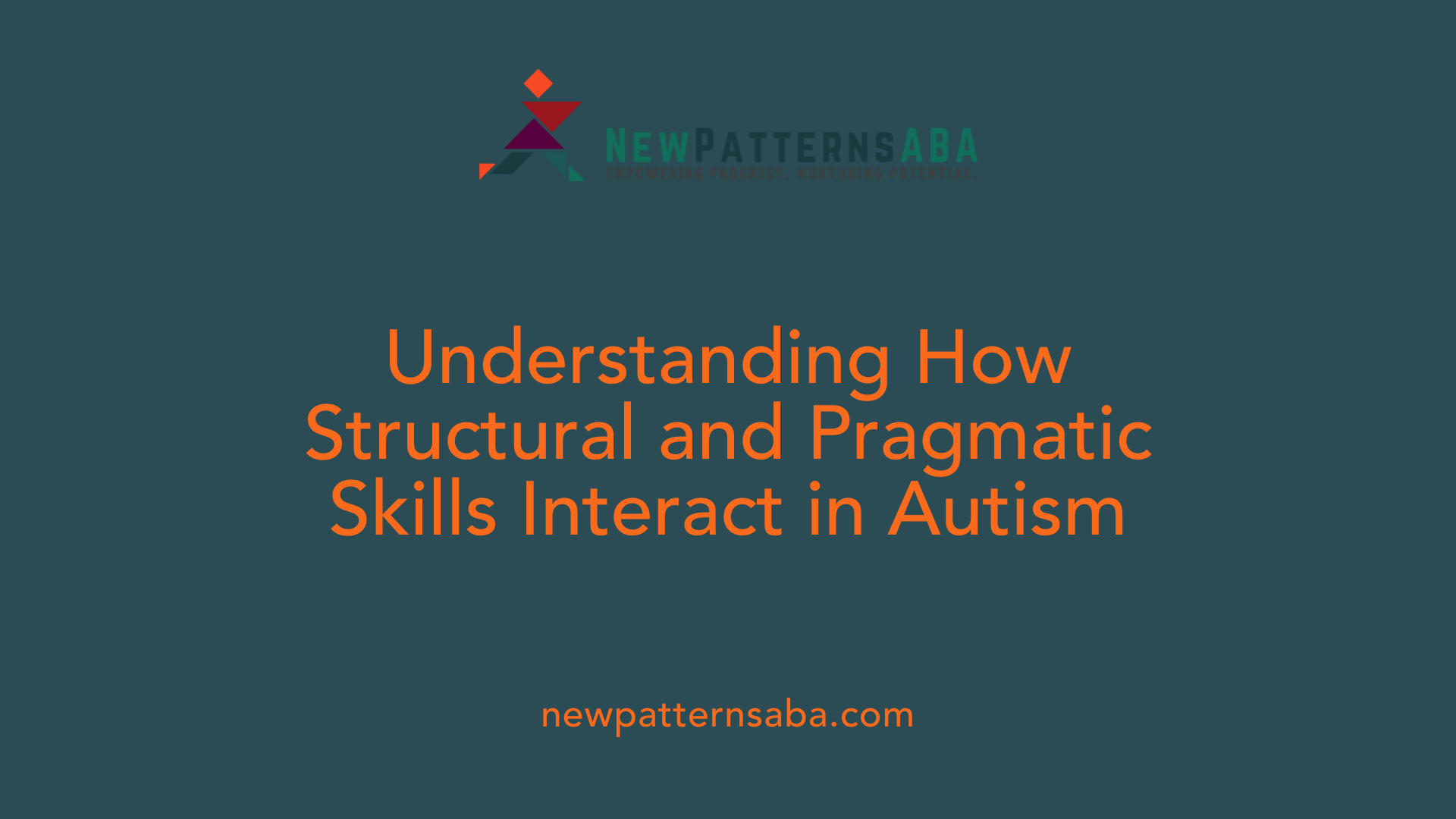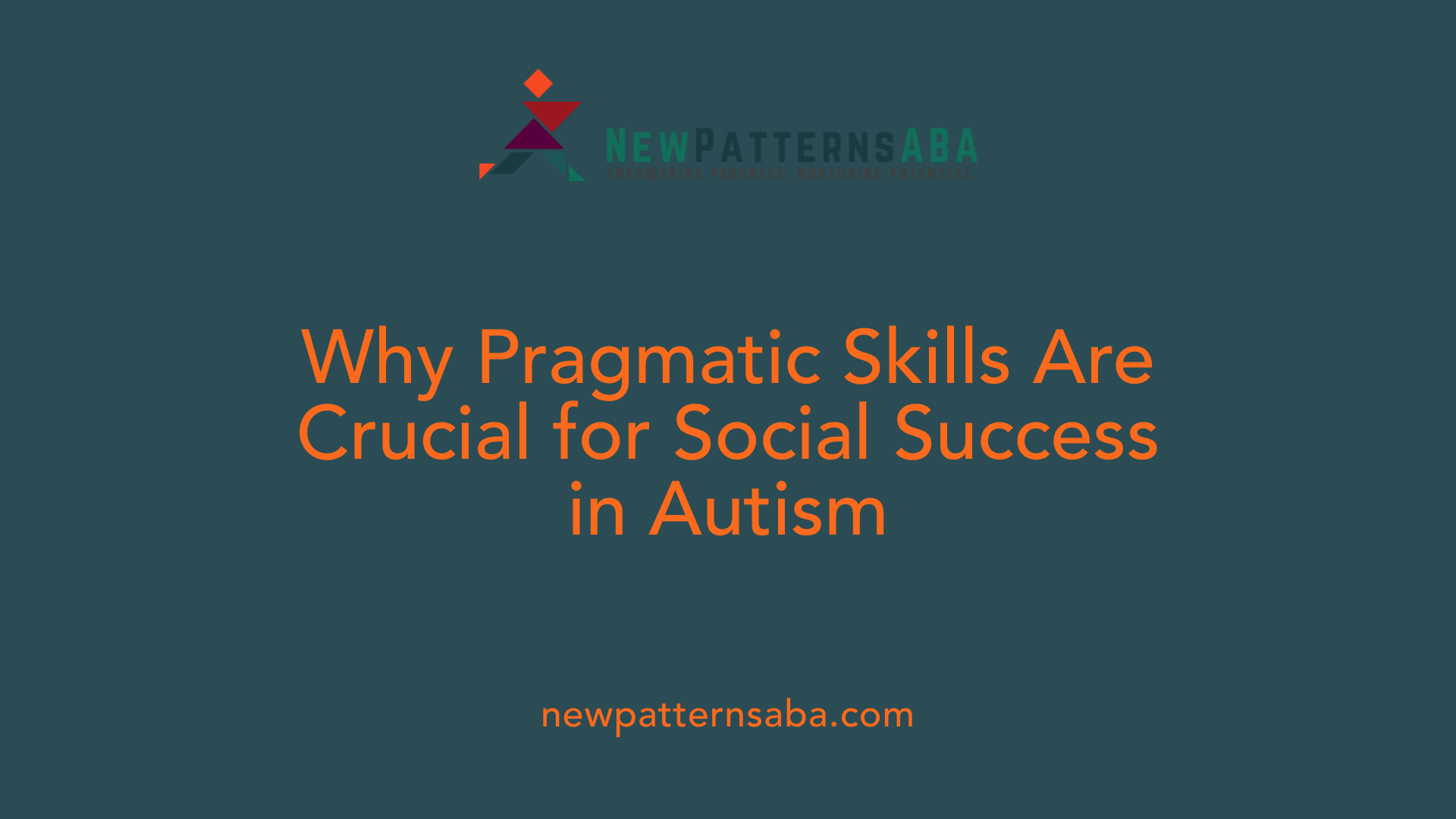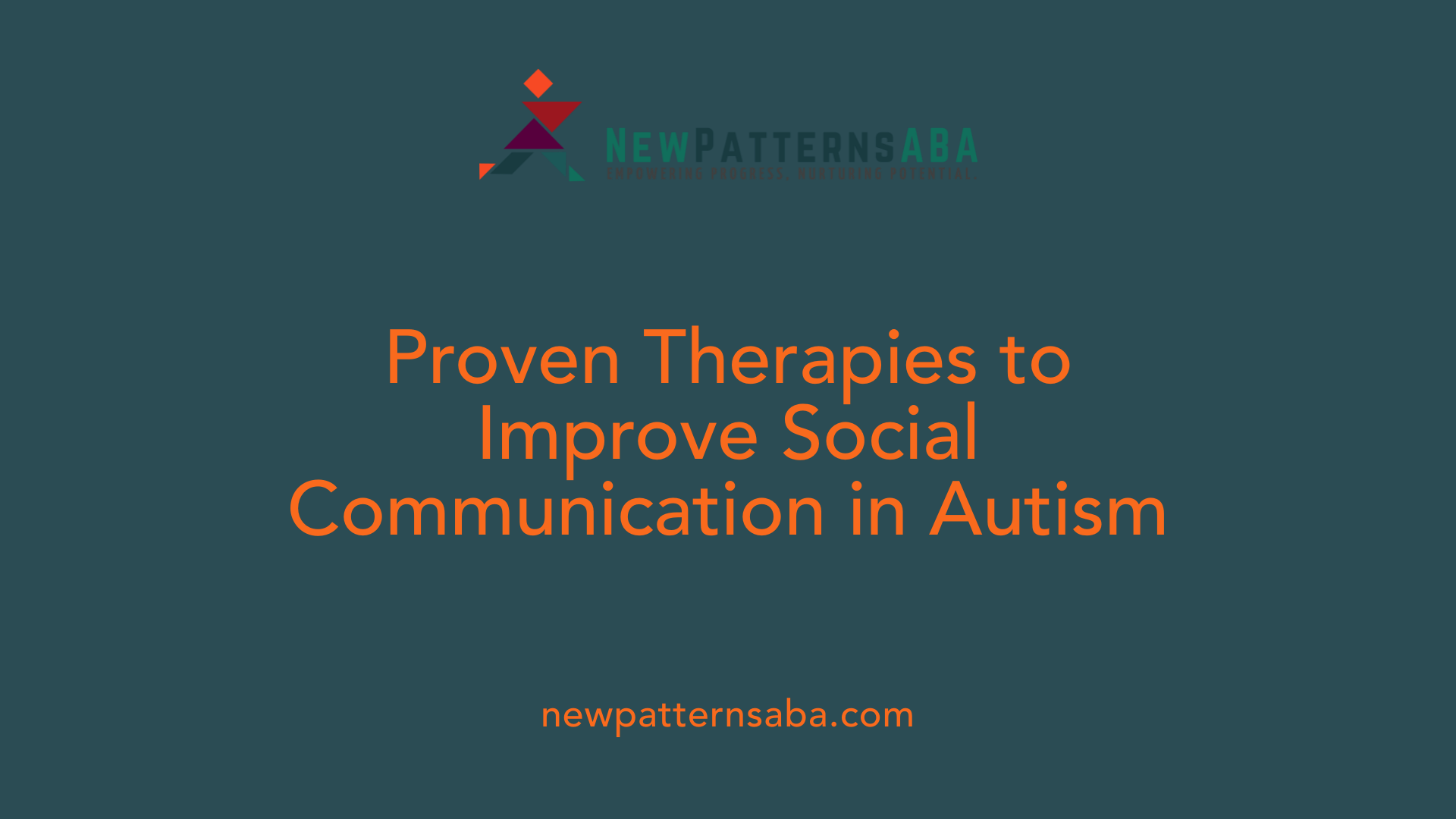Decoding the Social Challenges of Autism through Pragmatic Language
Unveiling the Complex World of Pragmatic Language in Autism
Pragmatic language— the social use of language— is a core component of communication that enables individuals to engage meaningfully within their social environments. In autism spectrum disorder (ASD), pragmatic language impairments represent some of the most significant barriers to social interaction, affecting relationship building, emotional understanding, and successful communication. This article explores the definition, characteristics, assessment, and interventions related to pragmatic language issues in autism, highlighting its critical role in social functioning and overall quality of life.
Understanding Pragmatic Language Issues in Autism

What are pragmatic language issues in autism, and what are their key characteristics?
Pragmatic language issues in autism refer to difficulties in using language effectively within social settings. These challenges are centered on how children and adults with autism communicate with others to build relationships, share interests, and participate in social life.
One of the main features is trouble with turn-taking during conversations. Individuals may speak at inappropriate times or struggle to wait for their turn, disrupting the flow of dialogue. They often have difficulty interpreting non-verbal cues such as facial expressions, gestures, and eye contact, which are integral to understanding social context.
Adjusting language based on the situation or the listener is another challenge. For example, someone with autism might use the same tone and style of communication when talking to a friend, a teacher, or a stranger, without adjusting for formality or familiarity.
Children with autism also face struggles in understanding and using figurative language, metaphors, idioms, and sarcasm. They may interpret language literally, missing the implied meaning and humor that others understand easily.
These pragmatic impairments significantly impact social interactions. Difficulties in initiating conversations, maintaining eye contact, and sharing emotions can hinder friendship development and social acceptance.
Compared to other developmental disorders, these pragmatic language challenges are typically more severe and persistent in autism. They often require targeted assessment and intervention.
Assessment tools such as the Children’s Communication Checklist-2 (CCC-2) and the Test of Social Pragmatics (TOPL) help evaluate these skills, guiding appropriate therapy approaches.
Interventions focus on social skills training, practicing communication routines, role-playing, and involving parents in therapy. Speech-language pathologists often lead these efforts, aiming to improve both verbal and non-verbal pragmatic skills.
In summary, pragmatic language issues are core to autism’s social communication profile. Addressing these challenges is crucial for helping autistic individuals improve their social relationships and overall quality of life.
Relationship Between Structural and Pragmatic Language Skills

How are pragmatic language impairments related to structural language skills in individuals with autism?
Pragmatic language difficulties are a hallmark of autism spectrum disorder (ASD). These impairments involve challenges in the social use of language, such as initiating conversations, understanding non-verbal cues, and adapting communication to different social contexts.
In many cases, children with ASD also experience structural language deficits, which include issues with syntax, vocabulary, and speech clarity. However, the relationship between these two aspects of language is complex. Research indicates that pragmatic skills often correlate with the severity of autism symptoms and level of social engagement.
Many children demonstrate both pragmatic and structural difficulties, but some may experience more profound issues in one area than the other. For instance, a child might have relatively intact vocabulary but struggle with turn-taking and maintaining topics during conversations.
Assessment of both pragmatic and structural language abilities provides a fuller picture of an individual's communication capabilities. It helps clinicians identify specific needs and tailor interventions effectively.
Evidence suggests that deficits in structural language—such as poor syntax or limited vocabulary—can influence pragmatic competence. When structural language skills are weaker, it may be harder to use language flexibly and appropriately in social settings.
Conversely, some children manage to develop structural language skills relatively well but still encounter pragmatic challenges, possibly affecting their social participation and future interactions.
The interaction between these language domains varies among individuals. This individual variation underscores the importance of personalized evaluations to inform targeted therapy.
In summary, pragmatic impairments are deeply intertwined with structural language skills in autism, but their relationship is nuanced. Both domains are critical in understanding communication difficulties and developing effective support strategies.
Assessment Methods for Pragmatic Language Difficulties

What assessment methods are used to identify pragmatic language difficulties in individuals with autism?
To evaluate pragmatic language challenges in individuals with autism, clinicians employ a variety of assessment tools that combine formal tests, observational techniques, and questionnaires. These methods aim to capture how well a person uses language in social contexts, beyond merely understanding grammar and vocabulary.
Standardized assessment tools are often central to this process. Tests such as the Comprehensive Assessment of Spoken Language (CASL) include specific subtests like Pragmatic Judgment and Inferences, which measure an individual’s ability to interpret social cues and use language appropriately in social situations. These tests are validated and correlate with real-world social functioning, providing an objective measure of pragmatic competence.
In addition to standardized tools, observational and interview-based techniques are crucial. Clinicians observe a person during structured activities or natural interactions to see how they manage turn-taking, respond to others, and interpret nonverbal cues. Interviews with parents, teachers, or caregivers also help gather insights into everyday communication skills and social behaviors that might not surface in testing environments.
Questionnaires completed by parents or teachers—such as the Children’s Communication Checklist, 2nd Edition (CCC-2)—offer valuable information about pragmatic language use in different settings. These checklists assess skills like initiating conversations, understanding social rules, and making appropriate responses.
Furthermore, language sampling involves recording and analyzing spontaneous speech during conversation or play. This technique provides detailed information about a person’s pragmatic abilities, including topic maintenance, coherence, and use of nonverbal communication.
Combining these methods allows for a comprehensive understanding of pragmatic language abilities, essential for designing targeted interventions. Early and accurate assessment ensures that individuals receive appropriate support to improve their social communication skills.
| Assessment Method | Purpose | Example Tools | Additional Notes |
|---|---|---|---|
| Formal standardized tests | Measure specific pragmatic skills objectively | CASL, TOPL, Social Language Development Test | Reveal measurable deficits, differentiate from typical development |
| Observational techniques | Observe real-life social interactions | Structured play, natural conversation observations | Capture functional use, contextual behaviors |
| Interview and questionnaires | Gather insights from caregivers and teachers | CCC-2, Social Responsiveness Scale (SRS) | Offer contextual understanding and everyday relevance |
| Language sampling | Analyze spontaneous speech in real settings | Recordings of conversations or play | Highlight pragmatic skills like turn-taking and topic management |
Understanding how these assessment approaches complement each other helps clinicians accurately diagnose pragmatic language difficulties. This comprehensive evaluation guides effective intervention strategies tailored to the individual’s needs.
Significance of Pragmatics in Social and Overall Functioning

Why is pragmatics important for social communication and overall functioning in autism?
Pragmatics refer to the social aspects of language use, such as understanding social cues, maintaining conversations, and adjusting communication based on context. For individuals with autism, these skills are often impaired, which can significantly affect their ability to connect and communicate effectively in social settings.
Effective pragmatics allow people to interpret gestures, facial expressions, and tone of voice, enabling better understanding of others' intentions and emotions. When these skills are lacking, individuals may struggle with social reciprocity, making interactions feel challenging or awkward.
The impact of pragmatic deficits extends beyond communication. They influence the ability to form friendships, participate in group activities, and comprehend social norms. These difficulties can lead to feelings of social isolation and affect overall mental health and daily functioning.
In autism diagnosis, pragmatic language impairments are one of the core features. Children with autism typically show more profound challenges in pragmatics compared to those with other language disorders. These impairments often manifest as trouble staying on topic, responding appropriately, and using nonverbal cues such as eye contact and gestures.
Interventions that focus on improving pragmatic skills—like social stories, visual supports, and peer-mediated activities—are key to enhancing social understanding and communication. Addressing pragmatic deficits early can promote better social integration and improve quality of life.
Overall, recognizing and targeting pragmatic communication difficulties are essential for supporting individuals with autism in building meaningful relationships and functioning effectively in social environments.
Effective Intervention Strategies for Pragmatic Language Impairments

What are effective intervention strategies for addressing pragmatic language impairments in autistic individuals?
Children and adolescents with pragmatic language impairments, especially those on the autism spectrum, benefit from targeted intervention strategies that focus on improving social communication skills. An effective approach combines social skills training with speech-language therapy. These therapies emphasize core pragmatic skills such as turn-taking, understanding others’ perspectives, and using language appropriately within different social contexts.
One of the most impactful tools used in interventions is visual supports—such as picture schedules and social stories—that help children understand social cues and routines. Video modeling, where children observe and imitate social interactions, has also proven to be highly effective. These methods make abstract social rules tangible and easier to master.
Role-playing activities and social stories are used to teach and practice everyday social behaviors like greeting others, maintaining conversations, and understanding nonverbal cues such as facial expressions and gestures.
Active involvement of both caregivers and peers enhances intervention success. Training parents and teachers through coaching provides consistent and natural opportunities for children to practice social skills across different environments. Parent-mediated interventions empower families to reinforce skills regularly, leading to better generalization.
Group-based programs tend to have more significant effects than individual sessions because they provide real-time social interaction opportunities. Interventions delivered in clinics or clinical settings often show larger improvements than home-based programs, although both are important.
Customization is vital: tailoring strategies based on individual cognitive abilities, severity of impairments, and specific social challenges ensures more effective outcomes. Maintaining consistency across settings and involving multiple support sources helps maximize the development of pragmatic language skills.
In summary, effective intervention for pragmatic language impairments involves a mix of structured therapy sessions, visual and multimedia supports, active participation from family and peers, and individualized approaches designed to promote meaningful social communication in diverse contexts.
Research and Systematic Reviews on Pragmatic Language in ASD
Are there systematic reviews and scientific research studies on pragmatic language issues and interventions in ASD?
Yes, there is a substantial body of scientific research and systematic reviews dedicated to understanding and improving pragmatic language in children with autism spectrum disorder (ASD). These studies employ various research methods, such as randomized controlled trials, longitudinal studies, and literature reviews, to evaluate assessment tools, intervention strategies, and the underlying neurodevelopmental aspects.
Many reviews synthesize data from multiple individual studies, highlighting that interventions involving active participation from both children and caregivers tend to produce better outcomes. Group-based interventions, especially those involving peers, have demonstrated higher efficacy compared to individual therapy, although detailed data remain limited.
Research has also focused on the neural basis of pragmatic difficulties, using neuroimaging techniques like resting-state functional MRI to explore the brain mechanisms underlying social communication challenges.
Intervention approaches include social stories, comic strip conversations, video modeling, and naturalistic teaching strategies, all aiming to enhance social reciprocity, non-verbal cues, and understanding of social context. The importance of early, tailored intervention is echoed across studies, emphasizing the potential for improving long-term social and communicative skills.
Additionally, reviews examine assessment tools such as the Children’s Communication Checklist-2 (CCC-2) and the Test of Pragmatic Language (TOPL), which help differentiate ASD from other neurodevelopmental conditions and measure progress post-intervention.
Overall, the evidence indicates that multidisciplinary approaches, combining behavioral, neurological, and caregiver-involved strategies, are most effective. Ongoing research continues to address gaps in understanding how best to sustain and generalize pragmatic skills over time, with an emphasis on personalizing interventions based on individual needs.
Impact on Clinical Practices and Future Directions
The growing research base significantly influences clinical practice by supporting the use of evidence-based assessment tools and intervention methods. Clinicians are increasingly adopting naturalistic and peer-mediated approaches and emphasizing early intervention.
Future research aims to clarify long-term effects, optimize intervention delivery, and explore innovations like neuroimaging biomarkers and digital interventions. These developments are pivotal for advancing tailored, effective therapies that can lead to meaningful improvements in social communication for children with ASD.
Differences in Pragmatic Profiles Among Autism, DLD, and Typical Development
How do pragmatic language profiles differ among individuals with autism, Developmental Language Disorder (DLD), and typical development?
Children and adolescents exhibit distinct pragmatic language abilities depending on their developmental profile. Those with autism spectrum disorder (ASD) generally display more severe difficulties in social communication. These challenges manifest in tasks such as engaging in reciprocal conversations, understanding social cues, and adjusting communication styles based on context. Their pragmatic deficits tend to be inconsistent, often varying across different situations and social partners.
Children with Developmental Language Disorder (DLD) usually experience milder problems related more to structural aspects like vocabulary and syntax. Their social interactions are often less impacted compared to autistic peers. DLD-related pragmatic issues can include difficulties with word retrieval and sentence construction, but their social reciprocity and non-verbal communication are comparatively better preserved.
In contrast, typically developing (TLD) children typically show age-appropriate social and communication skills. Their pragmatic language use is flexible, context-sensitive, and aligned with social norms.
Summary of differences:
- Severity: Autism exhibits the most profound pragmatic disruptions, DLD shows moderate challenges, and TLD generally shows age-appropriate skills.
- Consistency: Challenges in autism are often inconsistent, fluctuating across settings and interactions, while DLD challenges are more stable and related to structural language.
- Social aspects: Autism's pragmatic difficulties are centered on social reciprocity, turn-taking, and understanding non-verbal cues. DLD primarily involves vocabulary and syntactic issues, with less pervasive social deficits.
Understanding these differences is crucial for accurate diagnosis and tailored intervention, as they highlight the distinct social communication profiles inherent to each condition.
| Aspect | Autism | DLD | Typical Development |
|---|---|---|---|
| Severity of pragmatic difficulties | High | Moderate | Low |
| Consistency | Inconsistent | Stable | Age-appropriate |
| Social communication focus | Major | Less affected | Typical |
| Non-verbal cues | Difficult | Less affected | Proficient |
| Structural language issues | Often absent | Common | Absent |
This comparison underscores the importance of comprehensive assessments to distinguish between these developmental profiles and to guide intervention strategies effectively.
Summary and Future Perspectives in Pragmatic Language Research
Addressing pragmatic language impairments in autism is crucial for improving social integration, emotional health, and overall quality of life. The current evidence underscores the importance of comprehensive assessment tools, personalized intervention strategies, and ongoing research to better understand the nuanced relationship between structural and pragmatic language skills. As research advances, particularly in neuroimaging and longitudinal studies, new pathways for intervention and early diagnosis are emerging. Enhancing pragmatic language skills not only facilitates social success but also contributes to developing a supportive environment that fosters communication, independence, and wellbeing for individuals across the autism spectrum.
References
- Social (Pragmatic) Communication Disorder
- Structural and Pragmatic Language Impairments in ...
- Social Communication and pragmatic skills of children with ...
- Meeting the Challenge of Social Pragmatics with Students on ...
- How is Pragmatic Language Disorder Treated?
- A systematic review of pragmatic language interventions for ...
- Pragmatic language markers of autism diagnosis and ...
- Research on pragmatic impairment in autistic children ...






